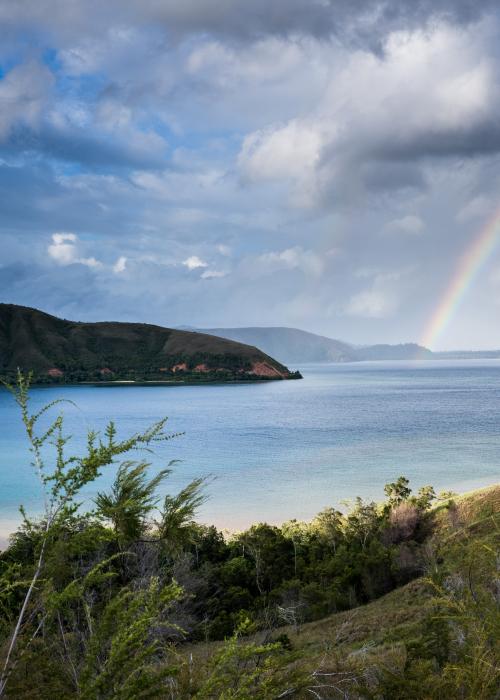
Endowment Fund for Sustainability in West Papua, Indonesia
Providing the policy proposal on Papua Endowment Fund for sustainability for the provincial Government of West Papua, Indonesia.
Aim
The program intends to respond to the recent developments on endowment fund or Dana Abadi in Indonesia, in particular, the development in line with the newly enacted legal frameworks on endowment funds, namely the law on intergovernmental fiscal relations (Undang-Undang Hubungan Keuangan Pemerintah Pusat dan Daerah, UU HKPD 1/2022) and the Government Regulation on special autonomy in Papua (PP 107/2021). Those legal frameworks have offered concrete and functioning proposals for the establishment of Papua endowment fund. However, since the context of the proposals is still general, there is a need to provide more detailed arrangements for the endowment fund model and management to fit with the context of subnational jurisdictions with special autonomy. Therefore, this program aims to provide a proposal for the Papua endowment fund with much more detailed arrangements to the Government of West Papua, Indonesia.
Where
West Papua, Indonesia.
Why
As sub-national jurisdictions with special autonomy status, Provinces in Papua are given the authority to govern their jurisdictions and development agendas, including their aspiration for sustainability as stated in the Manokwari Declaration 2018. Special autonomy for Papua is an affirmation policy given to all provinces in Papua, with the aim of accelerating development for the welfare of indigenous Papuans, indigenous peoples, and other local communities. In practice, however, the special autonomy of Papua operates following an asymmetrical decentralization arrangement that governs the relationship between national and sub-national governments. In the case of special autonomy funds, for instance, the use of the funds continues to comply with the national arrangements through an earmarking scheme. As such, the arrangement sometimes reduces the flexibility of provinces in Papua, even with special autonomy status, to manage and allocate funds according to their development needs and interests.
In turn, provinces like West Papua struggle to accomplish their lofty development targets, including preserving and conserving natural ecosystems for sustainability initiatives, due to the restrictive financing capacity. As for the latter, Papua stands as the world’s most floristically diverse island that is home to a variety of endemic fauna (e.g. bird species; birds of paradise) and carbon-rich mangroves possessing some of the highest carbon values in Indonesia (Nurhasan et al., 2022; Parsch et al., 2022; Cámara-Leret, 2020; Sasmito et al., 2020; Mudiyarso, 2015; Corlett and Primack, 2011; Marshall, 2007). These ecosystems are essential for the stability of the global environment and require huge financing commitments. Given such context, a more flexible yet reliable source of finance that may complement the limitations of the state budget money and special autonomy funds is critically needed, a trait that alternative financing mechanisms like endowment fund offer (Glorya, et al., 2022).
As a financing instrument, an endowment fund serves as one of the solutions to help with ongoing and long-term requirements for various objectives. The capital in the endowment fund is invested, and only the interest rates are used for financing any chosen activities. Its most distinctive feature is its capacity to function as a funding pool that can draw on a wide range of financial resources, spanning from public, private, and alternative finance. Endowment fund also differs from traditional public financing instruments in that they are not constrained by fiscal year restrictions, allowing for some degree of flexibility.
Given the right management and mechanisms, the endowment fund, which is developed and integrated into the overall development planning, financing, and licensing systems in Indonesian West Papua, would assist the jurisdictions in generating more funding and helping them finance their overarching sustainability target in a much more flexible manner.
How
Both UU HKPD 1/2022 and PP 107/2021 are the existing legal fundamentals for West Papua province in building their endowment fund. However, there are gaps as the two legal frameworks posit different interpretations of the endowment fund. Moreover, there are yet definitions of the endowment fund model, management structure, and functions compatible with the very arrangements of special autonomy of Indonesian West Papua under the existing legal frameworks.
At the moment, WRI Indonesia is working closely with, and supporting the Government of West Papua, Indonesia, through its Regional Research and Innovation Agency (BRIDA) to develop an endowment fund for sustainability proposals in West Papua, Indonesia. The proposals aim to synchronize the existing legal arrangements and recommend plausible models, management, and endowment fund functions better suited to the overarching development and sustainability contexts in West Papua, Indonesia.
As the lead resource organization with recognized expertise in public financing, WRI Indonesia will provide BRIDA with in-depth research, technical analysis, and expert consultation throughout the program. The endowment fund proposals will be crucial for key decision-makers in the West Papua province. We also anticipate the endowment fund proposals to serve as a reference for other provinces in the wider Tanah Papua and sub-nationals across Indonesia as they develop their own endowment funds.
Partners
- The regional government of West Papua, Indonesia through its Regional Research and Innovation Agency (BRIDA)
- The Working Team for the Formulation of Endowment Fund for Sustainability in the Province of West Papua, Indonesia, formed and appointed by BRIDA: WRI Indonesia, EcoNusa, RCCC & CCSF Universitas Indonesia, WWF Indonesia, Yayasan Konservasi Indonesia
References
Cámara-Leret R, Frodin D, Adema F, Anderson C, Appelhans M, Argent G et al. New Guinea has the world’s richest island flora. Nature. 2020;584(7822):579-583. doi: 10.1038/s41586-020-2549-5.
Corlett RT, Primack RB. Tropical Rain Forests: An Ecological and Biogeographical Comparison. 2nd Ed. Wiley-Blackwell; 2011. Cummine A. Citizen's Wealth: Why (and how) sovereign funds should be managed by the people for the people. New Haven and London: Yale University Press; 2016.
Glorya MJ, Mumbunan S, Primadevi S, Ardafillah M, Kalmirah J, and Heatubun C. Funding for Sustainability: Three Challenges of Trust Fund Implementation in Papua, Indonesia. Preprints. 2022. doi: 10.20944/preprints202209.0266.v1.
Marshall AJ. The Diversity and Conservation of Papua’s Ecosystem in Marshal AJ and Beehler BM: The Ecology of Papua Part One. Singapore: Periplus Editions; 2007.
Mudiyarso D, Purbopuspito J, Kauffman JB, Warren MW, Sasmito S, Donato D, Manuri S, Krisnawari H, Taberima S, Kurnianto S. The Potential of Indonesian Mangrove Forests for Global Climate Change Mitigation. Nature Climate Change. 2015; 5(12): 1089- 1092. doi: 10.1038/nclimate2734.
Nurhasan M, Maulana A, Ariesta D, Usfar A, Napitupulu L, Rouw A, Hurulean F, Hapsari A, Heatubun C, and Ickowitz A. Toward a Sustainable Food System in West Papua, Indonesia: Exploring the Links Between Dietary Transition, Food Security, and Forests. Frontiers in Sustainable Food Systems. 2022: 5. doi: 10.3389/fsufs.2021.789186.
Parsch C, Benjamin W, Margaretha PA, Craig N, Holger K, Julian S. 2022. Papua At The Crossroads: A Plea For Systematic Conservation Planning In One Of The Largest Remaining Areas Of Tropical Rainforest. Frontiers In Forests and Global Change. 2022; 5(763131). doi: 10.3389/ffgc.2022.763131.
Sasmito SD, Sillanpää M, Hayes MA, Bachri S, Saragi-Sasmito MF, Sidik F, Hanggara B, Mofu WY, Rumbiak VI, Hendri, Taberima S, Suhaemi, Nugroho JD, Pattiasina TF, Widagti N, Barakalla, Rahajoe JS, Hartantri H, Nikijuluw V, Jowey RN, Heatubun C, zu Ermgassen P, Worthington TA, Howard J, Lovelock CE, Friess DA, Hutley LB, Murdiyarso D. Mangrove Blue Carbon Stocks and Dynamics are Controlled by Hydrogeomorphic settings and land-use change. Global Change Biology. 2020; 26:3028-3030. doi: 10.1111/gcb.15056.
